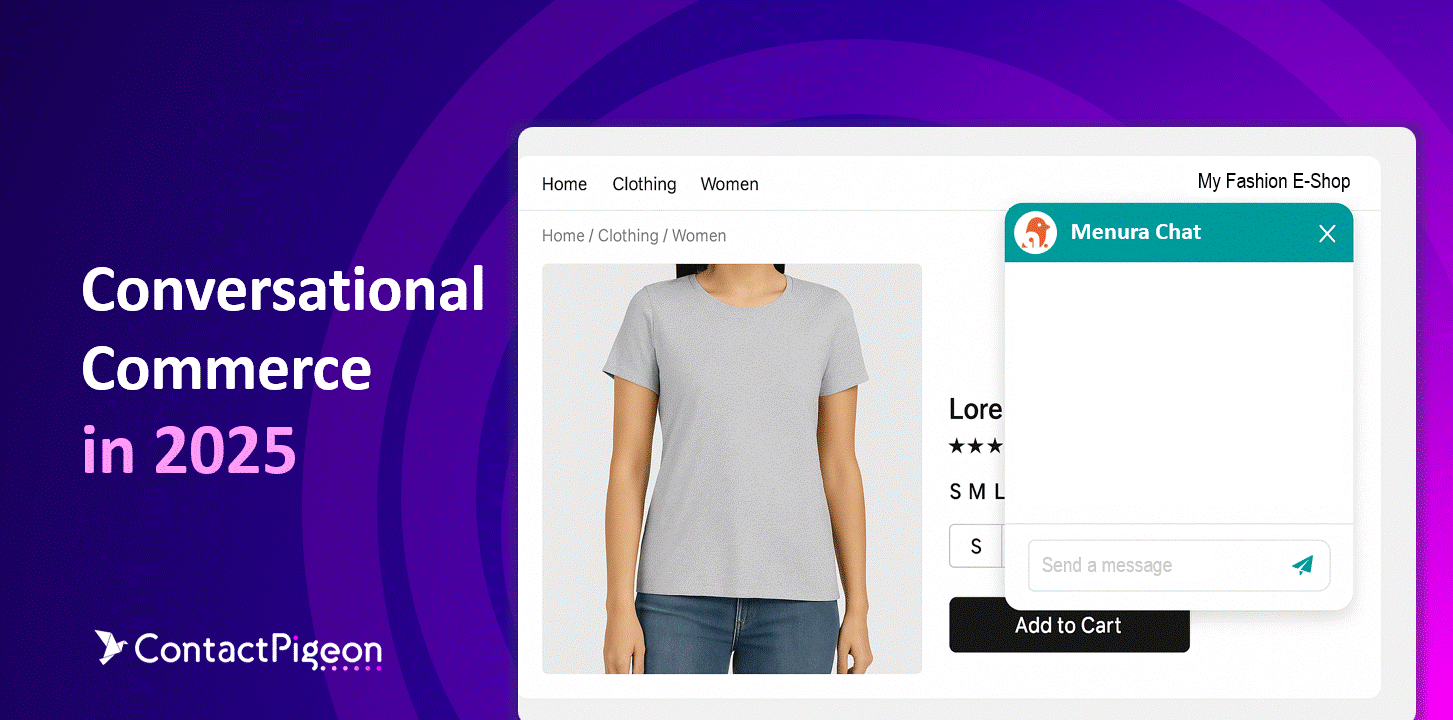Retail in 2025 is no longer about passive browsing or generic storefronts. It’s now defined by real-time, personalized interactions. At the heart of this transformation is conversational commerce in 2025, a strategic fusion of AI-driven messaging, voice commerce, and chat to guide shoppers across every stage of their journey. The global market for conversational commerce is expected to grow from $8.8 billion in 2024 to $52.8 billion by 2034, signaling an impressive 19.6% CAGR. From AI chat for retail to AI-powered retail assistants, retailers are deploying intelligent touchpoints that feel human, work 24/7, and scale effortlessly.
In a time crunch? Listen on the go!
What is conversational commerce?

At its core, conversational commerce refers to the use of real-time digital conversations, via chat, voice, and messaging, to facilitate and enhance the shopping experience. It combines human-style engagement with the scalability of automation, delivering high-ROI customer interactions. It fuels product discovery, checkout, support, and loyalty across channels like WhatsApp, Messenger, and Alexa.
Live chat vs. AI-powered chatbots
Traditional live chat is now eclipsed by AI-powered retail assistants. These intelligent bots answer questions, recommend products, and complete transactions autonomously,driving speed, satisfaction, and retention at scale. Brands benefit from a dramatic reduction in customer service costs while maintaining high satisfaction levels. AI chatbots also operate 24/7 without breaks, unlike human agents.
Messaging apps lead the way
Apps like WhatsApp, Messenger, and WeChat have become central to any retail chatbot strategy, enabling personalized, one-to-one messages for cart reminders, back-in-stock alerts, loyalty incentives, and more. These channels are increasingly preferred by mobile-first shoppers, especially Gen Z and Millennials, who seek fast, intuitive digital experiences.
Voice commerce: Shopping hands-free
Voice commerce lets customers shop via Alexa or Google Assistant, ideal for hands-free reorders or status updates. With better NLP and personalization, voice is emerging as a vital interface in retail. Consumers can simply ask to reorder products, check delivery status, or receive personalized recommendations without lifting a finger.
Generative AI in conversational commerce
Retail automation AI powered by generative AI now tailors interactions in real time. These systems analyze sentiment, past behavior, and preferences to deliver hyper-personalized journeys and eCommerce personalization that boosts conversion. As generative AI continues to evolve, expect smarter, more context-aware experiences that adapt continuously to shopper behavior.

Build smarter customer journeys and activate AI-driven personalization for repeat purchases.
Why conversational commerce is dominating in 2025
Conversational commerce is surging as AI has matured to deliver real business value, consumers overwhelmingly shop via mobile, trust hinges on secure and transparent data handling, and shoppers demand instant service. Retailers that invest in AI‑powered chat, messaging and voice platforms are well‑positioned to meet these macro shifts and capture the next wave of growth.
AI maturity and generative AI’s impact
- Enterprise adoption has hit a tipping point. McKinsey’s 2025 State of AI survey found that more than three‑quarters of organizations now use AI in at least one business function, and generative AI adoption is “rapidly increasing”. Retailers are moving beyond pilots to full‑scale deployments because AI has become reliable, governed and ROI‑positive.
- Generative AI is unlocking massive value. McKinsey estimates that gen‑AI could unlock $240–$390 billion in economic value for retailers, equivalent to a 1.2‑1.9 percentage‑point margin boost. This potential encourages brands to embed AI chatbots and voice assistants across the customer journey.
Mobile‑first behavior
- Smartphones dominate shopping. According to Statista data (reported by Exploding Topics), smartphones account for 77% of global retail website visits and 68 % of online orders. This mobile dominance means customers expect conversational interfaces, WhatsApp, Messenger or in‑app chat, rather than desktop‑centric experiences.
- Internet use is overwhelmingly mobile. In 2025, over 64% of all website traffic comes from mobile devices, and 96.3% of internet users access the internet via a mobile phone. A mobile‑first world drives retailers to adopt omnichannel messaging and voice commerce so that customers can shop and get support from anywhere.
Digital trust and data privacy expectations
- Trust is eroding. The Thales 2025 Digital Trust Index surveyed 14,000 consumers and found that no industry achieved more than 50% trust, and overall trust in digital services is declining. Consumers are more aware of cyber‑threats and bots, and they expect brands to address them.
- Customers demand privacy and security. Over 86 % of consumers expect data‑privacy rights, and 64% say their confidence would increase if brands adopt advanced technologies to protect data. A third (33%) of consumers are frustrated when “bad bots” manipulate the purchasing process. Conversational systems must therefore be secure, transparent and compliant, reinforcing the importance of trusted AI.
Demand for instant, frictionless interactions
- Self‑service has become the norm. According to Gartner, 60% of customers prefer AI-powered self-service options. Customers expect immediate answers through chatbots and voice assistants rather than waiting for a human agent.
- AI reduces costs and boosts satisfaction. McKinsey’s research on contact centers notes that companies implementing AI‑powered solutions report a 30% reduction in operating costs. This cost efficiency reinforces the case for conversational commerce, allowing retailers to deliver 24/7 personalized support while freeing up human staff for complex tasks.
Strategic applications of conversational commerce in retail

As conversational commerce 2025 matures, its influence is felt across every phase of the retail journey. From product discovery to post-purchase care, leading retailers are embedding AI into key touchpoints to unlock measurable ROI, optimize CX, and scale engagement.
Product discovery & guided selling
AI-powered retail assistants mimic in-store associates. By asking the right questions and analyzing behavior, they deliver real-time product suggestions that increase AOV and reduce decision fatigue. For example, a shopper seeking skincare can receive instant recommendations based on their past purchases and skin type, driving both satisfaction and sales.
Automated replenishment & subscription reminders
Using behavior triggers and AI-powered automation, brands now notify customers when it’s time to reorder essentials or renew subscriptions, improving CLV and reducing churn. These reminders reduce missed renewals and encourage habitual buying, especially in CPG and wellness verticals. The automation behind these nudges drives efficiency at scale.
Post-purchase support & returns
Shoppers can resolve issues through WhatsApp, Messenger, or Instagram DM without ever calling support. AI chat for retail streamlines returns, answers FAQs, and escalates to human agents when needed. This model not only reduces ticket volumes but also aligns with the expectation of 24/7, low-effort customer care.
Voice commerce: Ambient convenience
Voice interfaces powered by generative AI enable repeat purchases, subscription updates, and hands-free browsing. With over 500 million Alexa devices sold, and global voice-assistant spending projected at $20B by 2023, voice commerce is now mainstream. Expect future innovations to integrate AI into wearable tech, connected cars, and smart home systems.
Technologies powering conversational commerce

Behind every successful conversational commerce strategy lies a stack of powerful technologies. These tools, from generative AI and voice interfaces to unified messaging platforms, are what enable real-time, intelligent, and seamless shopping experiences across channels.
- NLP/generative AI: Natural‑language processing combined with generative AI makes conversational interfaces feel like a real‑life associate. Modern large‑language‑model assistants can understand free‑form questions, generate product recommendations and interpret sentiment.
- CRM-integrated chatbots: Bots that access CRM data can personalize responses using order history, loyalty status, and preferences, boosting conversion and retention. These bots adapt responses based on loyalty tier, seasonal behavior, and even customer sentiment.
- Voice AI/smart speakers: Voice commerce is a subset of conversational commerce; it converts spoken commands into text, applies NLP and completes the transaction. Adoption is rising rapidly: more than 500 million Alexa devices have been sold, and global voice‑assistant purchases jumped from $4.6 billion in 2021 to nearly $20 billion in 2023.
- Unified messaging platforms: Unified messaging consolidates emails, SMS, social DMs and live chat into a single inbox, giving agents a complete customer view. Businesses that embrace omnichannel engagement retain about 89% of their customers versus just 33% for those with fragmented channels
- API integrations with eCommerce stacks: Robust API connectors tie conversational interfaces to your commerce backend, inventory and logistics systems. These integrations enable scalable retail chatbot strategies across multiple storefronts, powering real‑time personalization and efficient fulfillment without custom development.
Benefits: Beyond engagement, toward profitability

Conversational commerce in 2025 is driving measurable business outcomes. From reducing acquisition costs to increasing conversion rates and delivering personalized experiences at scale, the benefits go far beyond customer satisfaction.
1. Higher conversion rates
Conversational commerce measurably improves conversions, as it goes beyond just meeting customers where they are. McKinsey reports that personalization delivers a 10–15% lift in sales conversion and 20–30% improvement in employee engagement. Embedding AI chat for retail or voice commerce into the shopping flow reduces friction and accelerates purchase decisions. Conversations drive trust, and trust drives action.
2. Lower acquisition costs
Targeted conversations can lower acquisition costs dramatically. McKinsey finds that effective personalization cuts acquisition costs by up to 50%, boosts revenue 5–15%, and improves marketing ROI by 10–30%. Conversational commerce focuses outreach and reduces wasted spend. It also enhances lookalike audience targeting by capturing rich first-party insights.
3. Scalable personalization
The ultimate promise of conversational commerce is personalization at scale, and the financial impact is substantial. McKinsey notes that companies excelling at personalization generate 40% more revenue from these efforts than their peers, with typical revenue lifts of 10–15%. In retail, personalization at scale yields a 1–2 % increase in total sales (higher for non‑grocery segments) and cuts marketing and sales costs by 10–20%.
Conversational commerce KPIs for retailers
To ensure measurable ROI from conversational commerce in 2025, retailers must track the right performance indicators. The table below outlines five essential KPIs that gauge effectiveness across messaging, chat, and voice commerce, helping executives align strategy with customer experience and revenue growth.
| KPI Name | What It Measures | Target / Benchmark (2025) |
|---|---|---|
| Engagement Rate per Messaging Channel | The percentage of customers who actively engage with brand-initiated messages across platforms like WhatsApp, Messenger, or SMS. | 25–35% engagement on opted-in, personalized messaging campaigns. |
| Cart Completion via Chat | The percentage of initiated checkouts completed through conversational interfaces (chatbot or live agent). | 15–25% completion rate across high-intent journeys. |
| Average Response Time (Bot + Human) | The average time it takes for a bot or agent to respond to a customer inquiry during a conversational session. | <5s (bot), <45s (human handoff) |
| CSAT (Customer Satisfaction via Conversation) | The average customer satisfaction score collected post-interaction within chat or voice channels. | 4.4+ / 5 stars or 85%+ satisfaction rate. |
| Revenue Per Conversation | The average revenue generated from a single messaging or voice interaction session that includes product discovery or checkout. | $3–$8 per conversation, depending on vertical. |
How to launch a conversational commerce strategy
Implementing a successful conversational commerce program requires more than deploying a chatbot. Brands must align technology, data and customer experience to achieve measurable business outcomes. Here’s a five‑step approach to get started.
Step 1: Define use cases with business impact
Map the customer journey and target use cases like guided selling, subscription renewals, and support. Focus on interactions that influence revenue or retention. Include both high-touch and high-volume stages.
Step 2: Choose the right platforms
Select channels based on customer behavior: WhatsApp, Messenger, or voice commerce via Alexa and Google Assistant. Prioritize scalability, data security, and responsiveness. Consider SMS for urgent alerts and web chat for desktop users.
Step 3: Integrate CRM and first-party data
Use CRM-integrated bots to personalize at scale. Access to purchase history and preferences makes AI-powered retail assistants significantly more effective. Integration with loyalty programs and CDPs can also enrich responses.
Step 4: Build conversational flows
Use decision trees and NLP to design intelligent flows. Automate FAQs and sales journeys while enabling smooth handoffs to human agents when needed. Build fallback mechanisms for unknown inputs and test flows for edge cases.
Step 5: Measure, optimize, scale
Track metrics like cart completion, AOV, CSAT, and agent deflection. Run pilots, refine based on insights, then scale across regions and verticals. Regularly update scripts based on top queries and business goals. Leverage insights for personalization tuning.
Conversational commerce is the new frontline
Conversational commerce, powered by AI chat for retail, voice commerce, and messaging platforms, has redefined the customer journey from start to finish. It transforms static shopping into dynamic dialogue, guiding customers with personalized recommendations, frictionless support, and real-time engagement across every channel. It’s how brands meet rising expectations, deliver seamless, omnichannel CX, and stay agile in a fast-changing digital economy. Those who invest in conversational strategies today will shape the retail leaders of tomorrow. By combining AI chat for retail, voice commerce, and omnichannel communication, brands can turn every interaction into a revenue opportunity.
As technology matures and consumer expectations rise, the winners will be those who build intelligent, scalable, and human-centric conversations that convert. Discover how conversational commerce can elevate your retail experience. Book a free demo with ContactPigeon to see what’s possible.



